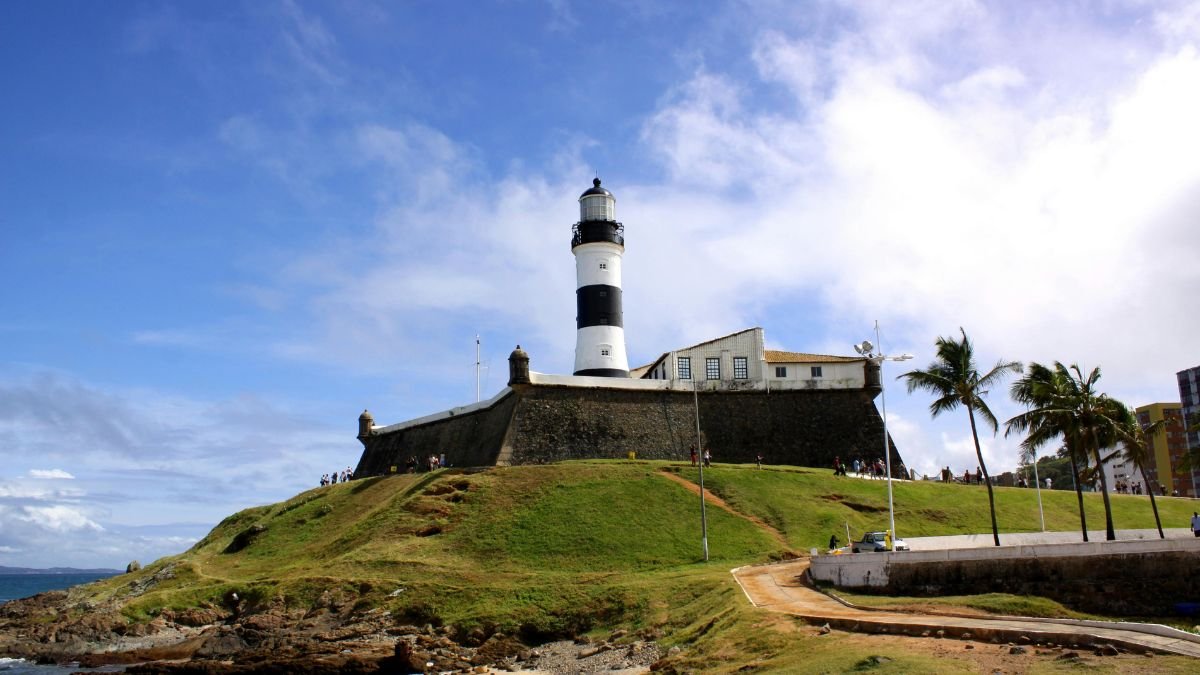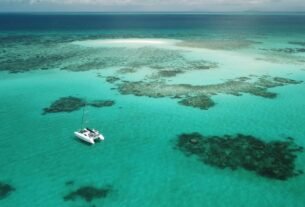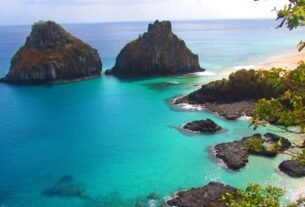Introduction
Have you ever wondered what makes a city pulse with life beyond its streets? In Brazil’s former colonial capital, Salvador, the answer lies in its soul-stirring blend of history, rhythm, and flavor that captivates both locals and visitors alike.
This city, steeped in rich traditions and diverse cultural influences, showcases an extraordinary tapestry woven from centuries of African, Portuguese, and indigenous heritage. With over 4 million residents, this vibrant metropolis is a UNESCO World Heritage Site, celebrated for its Afro-Brazilian roots and electrifying energy that radiates through its lively neighborhoods and festive celebrations.
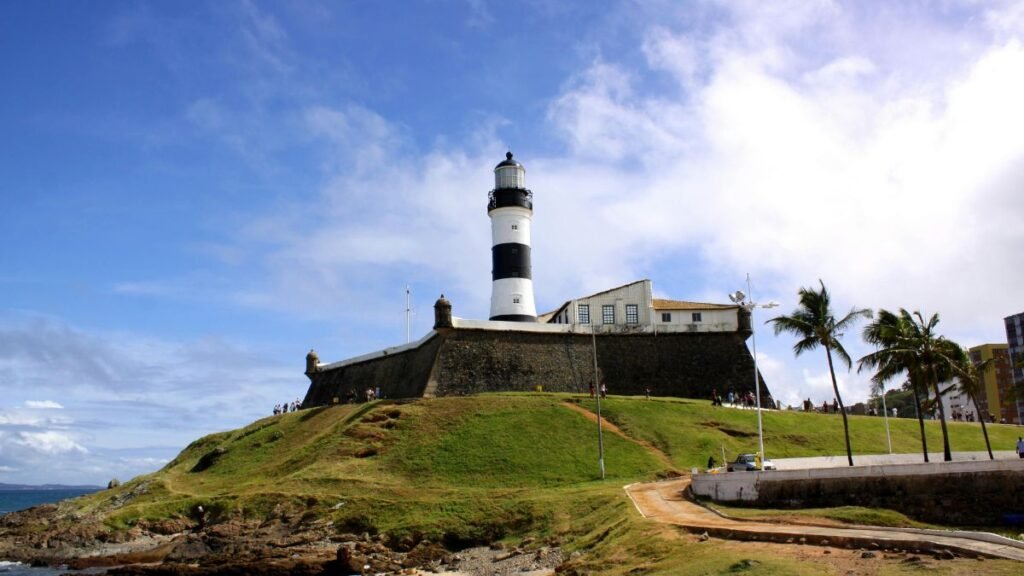
From the golden hues of Pelourinho’s colonial architecture to the hypnotic beats of capoeira, every corner tells a story. The air hums with samba, the aroma of acarajé fills the streets, and Carnival transforms the city into a kaleidoscope of joy. Here, culture isn’t just observed, it’s lived.
Ready to uncover seven unforgettable experiences? Let’s dive into the heart of Bahia’s most iconic treasures.
KEYWORDS
- Home to 4 million people, it’s Brazil’s third-largest urban hub.
- A UNESCO site with deep Afro-Brazilian influences.
- Famous for colonial landmarks, lively music, and spicy cuisine.
- Capoeira and Carnival showcase their dynamic spirit.
- Local festivals and dishes provide an authentic cultural immersion experience.
Introduction to Salvador
Founded in 1549, this coastal gem was once the heartbeat of colonial Brazil. Perched above the Bay of All Saints, its location made it a strategic hub for trade and culture. For over 200 years, it held the title of the nation’s first capital, shaping its identity.
The city is famously split between Upper and Lower districts, connected by steep cliffs and the iconic Elevador Lacerda. Below, the port welcomed over 4 million enslaved Africans, leaving an indelible mark on its Afro-Brazilian soul.
Today, the streets of Pelourinho pulse with color. Capoeira circles form spontaneously, and the scent of dendê oil drifts from food stalls. ‘You don’t just visit here, you feel it,’ says a local musician, grinning as a samba drumline passes. That same vibrant energy can be felt in João Pessoa, PB, where cultural traditions, music, and coastal beauty blend to create an atmosphere that’s both welcoming and alive with history.
Tropical warmth lingers year-round, with rains peaking from March to June. But even showers can’t dampen the energy. Evenings bring impromptu concerts under colonial arches, proof that history here is alive and dancing.
Why is Salvador a Cultural Gem?
Few places capture the essence of living heritage like this coastal capital. UNESCO calls its historic center ‘the richest collection of colonial architecture in the Americas.’ But beyond pastel facades, the city thrives as the epicenter of Afro-Brazilian culture. Here, capoeira isn’t just a martial art; it’s a dance of resistance.
Candomblé ceremonies echo ancestral traditions, while samba-reggae music fuels street celebrations. The rhythmic heartbeat is undeniable, and it resonates far beyond the capital, reaching vibrant communities like Itacaré in BA, where culture and nature meet in perfect harmony.
The food scene is equally iconic. Bite into crispy acarajé, a fried bean cake with shrimp, or savor moqueca, a coconut-based seafood stew. These dishes tell stories of African, Indigenous, and Portuguese fusion.
| Festival | Highlights | Best Time to Visit |
|---|---|---|
| Carnival | Largest street party with Axé music | February |
| Lavagem do Bonfim | Religious procession with flower-scattered streets | January |
| Festa de Iemanjá | Tribute to the sea goddess with ocean offerings | February |
Baroque churches, such as São Francisco, dazzle with gold-leaf interiors. Yet, the real things to experience are spontaneous: a drum circle at sunset, a market vendor’s laughter, or the scent of dendê oil in the air.
This city rewards those who dive deep. Its intensity, whether in spicy flavors, pulsating beats, or vivid history, creates an unforgettable immersion.
1. Pelourinho: The Soul of Salvador
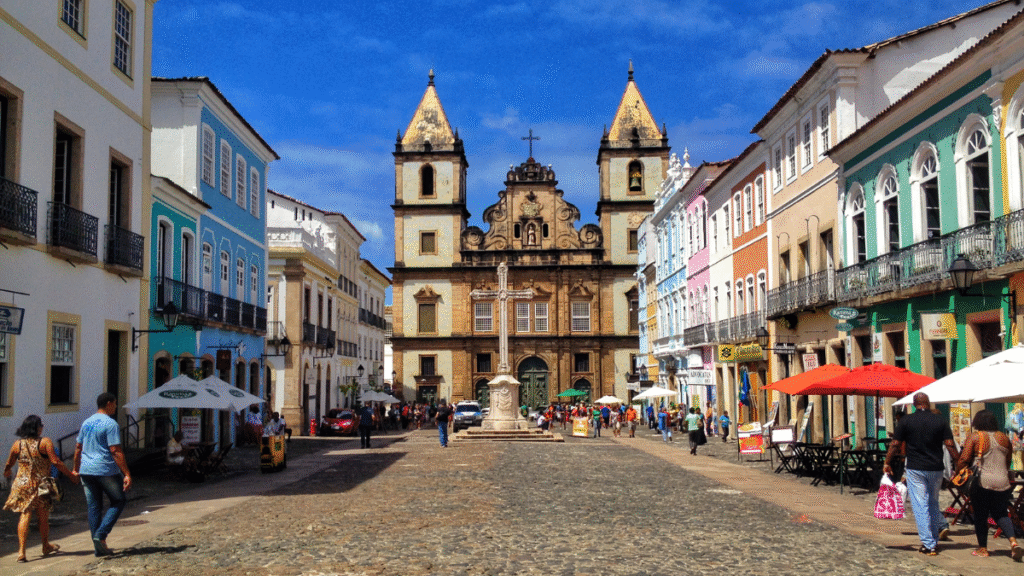
Once a site of suffering, now a celebration of resilience, Pelourinho’s story is etched in every pastel wall, telling tales of both hardship and hope. Its name, meaning ‘pillory,’ hints at a dark past as a slave punishment site, a grim reminder of the city’s history.
Today, it’s a vibrant world heritage site where Afro-Brazilian culture thrives, showcasing the enduring spirit of a community that has transformed pain into artistic expression and joy.
That same spirit extends along the Bahia coast to places like Morro de São Paulo in BA, where history, culture, and natural beauty come together in a uniquely uplifting atmosphere. Pelourinho earned UNESCO status for its unparalleled colonial legacy, recognized for its historical and cultural significance.
Over 800 buildings have been restored since the 1990s, their facades painted in sunlit hues of blue, yellow, and pink, creating a vibrant tapestry that reflects the area’s rich heritage. Landmarks like Praça da Sé whisper tales of the city’s layered history, inviting visitors to explore the stories of those who walked these streets long before us.
Colorful Colonial Architecture
Cobblestone streets wind past baroque churches and ornate balconies, each corner revealing a piece of history and artistry. The Fundação Casa de Jorge Amado celebrates Brazil’s literary giant, offering insights into his life and works.
At the same time, the Museu da Gastronomia Baiana showcases the region’s fiery flavors, providing a taste of its culinary heritage. Every corner is a photo op, with the colorful architecture and lively street art creating a backdrop that is both picturesque and steeped in cultural significance.
As dusk falls, the district pulses with energy. Drum circles erupt spontaneously, and capoeira’s fluid dance-like movements draw crowds. “This isn’t just a part of town, it’s the heartbeat of Bahia,” says a street performer.
| Must-Visit Spot | Highlight |
|---|---|
| Praça da Sé | Historic square with street performances |
| Igreja do Rosário dos Pretos | Church built by enslaved Africans |
| Olodum Rehearsal | Tuesday night samba-reggae sessions |
Pro Tip: Use a fanny pack for valuables and stick to bustling areas. Pelourinho’s magic is best enjoyed where the music and people are loudest.
2. Farol da Barra: Iconic Lighthouse and Beach
Standing tall since 1534, Farol da Barra is more than a lighthouse—it’s a sentinel of history. As the oldest in the Americas, it has guided ships through the Bay of All Saints for centuries, ensuring safe passage for countless mariners navigating these waters.
Its striking white and red striped tower, a beacon of hope and guidance, rises majestically against the backdrop of the Atlantic Ocean. Today, it’s a symbol of resilience, perched where the bay meets the Atlantic’s endless blue, and it continues to attract visitors from around the globe who come to marvel at its beauty and historical significance.
History of the Lighthouse
Built beside Santo Antônio da Barra Fort, the lighthouse now houses a nautical museum, which is a treasure trove of maritime history. Its walls whisper tales of colonial trade routes and pirate threats, evoking a sense of adventure and intrigue.
Locals say it’s still light, yet it feels like a guardian, marking the way home for sailors. This iconic structure has not only served as a navigational aid but also as a symbol of hope for those at sea, reminding them of the safety of land. Over the years, it has become a beloved landmark, representing the enduring spirit of the community that surrounds it.
Best Sunset Views
At dusk, crowds gather for a ritual: watching the sun melt into the water. The panoramic view from the fort’s terrace is unmatched, offering a breathtaking spectacle as the sky transforms into a canvas of vibrant oranges, pinks, and purples.
“It’s like the sky sets the ocean on fire,” a street vendor remarks, handing over a chilled coconut, inviting onlookers to savor the moment. This daily gathering not only highlights the natural beauty of the location but also fosters a sense of community, as locals and tourists alike share in the awe of nature’s display.
Nearby Attractions
The beach below, Praia do Farol da Barra, offers gentle waves for swimmers and surf breaks at high tide, making it a perfect spot for both relaxation and adventure. A short walk leads to Morro do Cristo, a hilltop statue with sweeping vistas that provide an excellent vantage point for panoramic photographs.
Don’t miss the Barra Nautical Museum—its artifacts reveal Bahia’s maritime soul, showcasing everything from ancient navigational tools to the rich stories of the sailors who once braved these waters. The museum serves as a poignant reminder of the region’s profound connection to the sea and its rich historical significance in maritime exploration.
- Local secret: Join the morning joggers who trek from Pelourinho to dip their toes in the sea, enjoying the refreshing waters as the sun rises over the horizon.
- Pro tip: Weekdays are quieter; weekends buzz with beachside drum circles, where the rhythm of the drums echoes the vibrant culture of Bahia, creating an atmosphere of joy and celebration.
3. São Francisco Church: Baroque Masterpiece
Gold leaf shimmers across every surface, a testament to colonial wealth and the enslaved craftsmanship that created it. Among Brazil’s finest buildings, the São Francisco Church is a Baroque masterpiece built in the 18th century by African and Indigenous laborers. Its interior dazzles with 100kg of gold leaf, intricate woodcarvings, and 55,000 azulejo tiles depicting St. Francis’s life.
The church’s design is a striking blend of European and African culture. Portuguese Baroque flourishes merge with native jacarandà wood sculptures, a silent homage to Bahia’s multicultural roots. Even the ceiling tells a story; gilded motifs hide symbols of resistance.
Visitors should join guided tours to decode hidden motifs. Mornings offer quieter moments to absorb the sanctuary’s glow. Even the pews, carved with tropical flora, invite reflection.
| Feature | Details |
|---|---|
| Gold Leaf | Covers altars, pillars, and ceiling |
| Azulejo Tiles | Covers altars, pillars, and the ceiling |
| Woodcarvings | Native jacarandà with African motifs |
After exploring, step into the church’s location—a prime spot near Pelourinho’s markets. Cafés spill onto plazas where capoeira circles form. “This church isn’t just a relic; it’s an integral part of the city’s soul,” says a local guide.
4. Capoeira: Dance, Music, and Martial Arts
More than a martial art, capoeira is a living dialogue between history and movement. Born from enslaved Africans in the 16th century, it disguised self-defense as dance to evade punishment.
This ingenious blend of artistry and combat not only served as a means of survival but also fostered a sense of community and identity among those who practiced it. Today, its acrobatic ginga swings and rhythmic berimbau beats pulse through Bahia’s streets, captivating audiences and participants alike, embodying the spirit of resilience and joy.
From Resistance to UNESCO Recognition
Banned until the 1930s, capoeira now holds UNESCO Intangible Cultural Heritage status, a testament to its cultural significance and the perseverance of its practitioners. Its roda (circle) gatherings blend kicks, flips, and call-and-response music, creating an electrifying atmosphere that celebrates both individual skill and collective spirit. “Every movement is a sentence; every roda, a conversation,” explains a mestro in Pelourinho, highlighting the art form’s deep connection to storytelling and cultural expression.
Where to Witness or Learn
Free classes at Forte da Capoeira immerse beginners in basics, providing an authentic introduction to this dynamic art form. For spontaneous spectacles, Largo do Pelourinho hosts nightly rodas under colonial arches, where locals and tourists gather to witness the breathtaking displays of skill and camaraderie. Barra Lighthouse offers sunset sessions, where you can learn to dodge like the pros with ocean views, making it a picturesque backdrop for honing your capoeira skills while enjoying the beauty of Bahia.
- Pro tip: Wear flexible clothing and join the clapping—it’s part of the rhythm, enhancing the communal experience.
- Cultural note: Respect the roda’s hierarchy; only enter when invited, as this demonstrates an understanding of the traditions and values that underpin this vibrant practice.
5. Afro-Brazilian Cuisine: A Flavorful Journey
The aroma of sizzling dendê oil and coconut milk fills the air. Welcome to Bahia’s culinary soul. Here, every dish is a vibrant part of history, blending African, Indigenous, and Portuguese traditions. From bustling markets to beachside stalls, food is a language of joy and resilience.
Must-Try Dishes: Acarajé and Moqueca
Acarajé reigns as the king of street food. These golden bean fritters, fried in dendê oil and stuffed with shrimp, are served by baianas in flowing white dresses. Bite into one at Rio Vermelho’s Acarajé da Cira, where recipes haven’t changed in decades.
For a hearty meal, dive into moqueca. This slow-cooked fish stew simmers with peppers, tomatoes, and cilantro in a creamy blend of coconut milk and dendê oil. Pair it with farofa (toasted cassava flour) for the perfect crunch.
Best Places to Eat
- Restaurante Maria Mata Mouro (Pelourinho): Colonial charm meets modern twists on classics.
- Cuco Bistrô: Oceanfront dining with fresh seafood moqueca.
- Street gems: Try tapioca crepes or grilled queijo coalho cheese from vendors.
End your meal with exotic fruits like sugar apple or cashew fruit—sweet, tangy, and uniquely Bahian. As a local chef says, “Our cuisine isn’t just eaten; it’s felt.”
6. Mercado Modelo: Shopping and Culture
Step into a world where history and commerce collide under one roof. Mercado Modelo buzzes with energy, boasting over 250 stalls that offer a diverse range of products, from handcrafted souvenirs to aged cachaça. This isn’t just a market—it’s where Bahia’s creative spirit shines brightest.
Here, you can find artisans showcasing their crafts, ranging from colorful beadwork to vibrant paintings that reflect the region’s rich cultural heritage. The atmosphere is alive with the sounds of vendors calling out their wares and the aroma of local delicacies wafting through the air, inviting you to explore further.
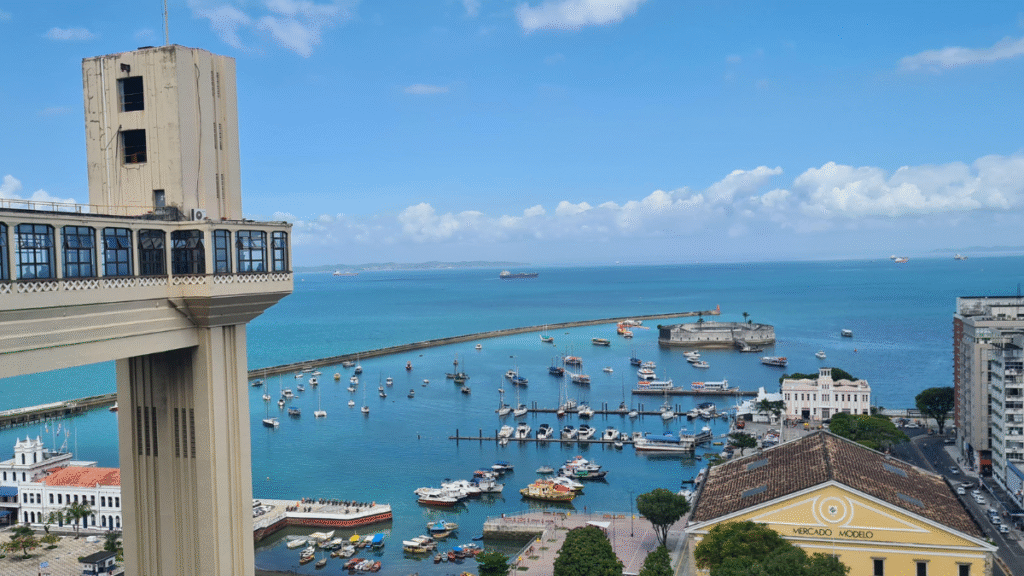
Built in 1861, the building originally served as a hub for slave trading. Today, its arched walkways house artisans carving wooden figurines and weaving delicate lace. The transformation from a painful past to a cultural epicenter makes it a must-visit destination.
Top finds to treasure:
- Hand-carved woodwork: Orisha statues with intricate details
- Rendado lace: Delicate textile art passed through generations
- Bahian paintings: Vibrant scenes of coastal life
The courtyard regularly hosts capoeira demonstrations—watch masters spin and kick to live berimbau rhythms. Time your visit for these impromptu shows; they turn shopping into a full sensory experience.
Just steps away, the iconic Elevador Lacerda connects the lower streets to the upper city. Ride up for panoramic views after browsing.
Pro tip: Politely decline overeager vendors—the best deals often come to those who wander calmly. As one shopkeeper advises, “Let the art choose you, not the other way around.”
7. Carnival in Salvador: The Ultimate Party
When the rhythm takes over, the streets transform into a living, breathing celebration. This carnival redefines festivity, drawing over 2 million attendees to dance under mobile stages called trios elétricos. Unlike Rio’s samba, Bahia’s heartbeat is Axé, a genre blending African percussion with reggae and pop.
The energy is palpable, with every corner filled with laughter, music, and the vibrant colors of costumes, as locals and visitors alike immerse themselves in this cultural extravaganza.
Each year, the streets come alive with parades, where the air is thick with excitement and the smell of street food wafts through the crowd, adding to the sensory overload of this unique celebration.
Axé Music and Street Celebrations
Axé music is the soul of the party. Stars like Ivete Sangalo lead blocos (parade groups), their high-energy performances turning avenues into dance floors. The streets pulse with drumlines, and crowds chant lyrics passed down through generations.
This infectious rhythm encourages everyone to join in, creating a sense of unity among the diverse crowd. The captivating beats of Axé music resonate with the heart of Bahia, as dancers of all ages sway to the rhythm, celebrating their heritage and the joy of being together in this electrifying atmosphere.
Tips for Attending
- Book early: Hotels often sell out 6 months or more in advance, so secure your accommodations as soon as possible to avoid disappointment.
- Dress smart: Closed-toe shoes protect feet in crowds; waist pouches keep cash safe. Consider wearing light, breathable fabrics to stay comfortable in the heat.
- Hydrate: Coconut water vendors are lifesavers, providing refreshing hydration as you dance and celebrate under the sun.
Prefer a quieter part of the action? Visit the Casa do Carnaval museum for year-round exhibits on costumes and rhythms. At night, stick to official blocos—their bright lights and security teams ensure a festive yet safe time.
Exploring Salvador’s Beaches
Golden sands meet rhythmic waves along Bahia’s stunning coastline. Each stretch offers a unique blend of history, adventure, and relaxation. Whether you seek lively drum circles, vibrant beach parties, or secluded cliffs for a moment of solitude, the beaches here never disappoint. The sound of laughter and music fills the air, creating an inviting atmosphere that beckons both locals and tourists alike to join in the festivities.
Porto da Barra Beach
Where the Portuguese first landed in 1549, Porto da Barra now enchants families with its tranquil waters and laid-back atmosphere. Sunset brings drum circles on the sand, join the rhythm or simply soak in the view, as the sun dips below the horizon, painting the sky in hues of orange and pink. Families set up picnics while friends play beach volleyball, creating a lively yet relaxed environment that makes it easy to lose track of time.
Praia do Farol da Barra
Surfers flock to the waves near the iconic lighthouse, drawn by the consistent swells that provide perfect riding conditions. Beachside kiosks serve frosty caipirinhas, perfect for watching the sky turn pink as the day fades into night.
For the best way to end a day, grab a drink and claim a spot on the seawall, where you can enjoy the gentle ocean breeze and the sound of waves crashing against the rocks. As night falls, the beach transforms into a vibrant social hub, with music and laughter echoing in the air.
Lesser-Known Gems
Escape crowds at Praia do Buracão, where cliffs frame turquoise coves, offering a stunning backdrop for sunbathing and swimming. Or visit Itapuã Beach, immortalized in Vinícius de Moraes’ poetry, where the tranquil waters invite reflection and relaxation.
These hidden spots reward those who wander off the beaten path, providing a sense of discovery and adventure that enhances the overall experience of Bahia’s coastal beauty.
- Safety tip: Avoid isolated areas after dark; keep your valuables close to ensure a worry-free visit.
- Local secret: Weekday mornings offer the calmest waters for swimming, making it the ideal time for a peaceful dip before the crowds arrive.
Historical Landmarks You Can’t Miss
History whispers through the iron gates and stone walls of these iconic sites. Beyond the vibrant streets, these landmarks reveal layers of colonial ambition, innovation, and resilience. Each offers a unique lens into the past, whether from a towering elevator or a clifftop fortress.
Elevador Lacerda: Gateway Between Worlds
Since 1873, this 72-meter Art Deco elevator has connected the Upper and Lower City. For just $0.15, riders soar between districts in 30 seconds, rewarded with a sweeping view of the bay. Night rides dazzle as city lights flicker below.
The buildings surrounding its base buzz with cafés and street performers. Locals joke it’s the “shortest commute with the longest history.” Operates 6 AM–11 PM daily.
Forte de Monte Serrat: Sentinel of the Bay
Perched on a strategic location, this 16th-century fort defended against Dutch invasions. Its cannons still point seaward, and the chapel’s Baroque altar gleams quietly. Climb the ramparts for 360-degree vistas—sunset paints the bay in gold.
Lesser-known but equally striking, Solar do Unhão is home to the Museu de Arte Moderna. This colonial mansion’s arcaded courtyard hosts jazz nights under the stars.
| Landmark | Highlight | Best Time to Visit |
|---|---|---|
| Elevador Lacerda | Panoramic bay views | Sunset (6–7 PM) |
| Forte de Monte Serrat | Cannons & chapel | Morning (fewer crowds) |
| Solar do Unhão | Art exhibits & concerts | Friday evenings |
Nightlife in Rio Vermelho
As the sun dips below the horizon, Rio Vermelho awakens with a surge of electric energy. This bohemian place is the epicenter of Bahia’s nightlife, where cobblestone streets hum with live samba rhythms and clinking glasses.
Head to Beco dos Artistas, a narrow alley lined with bars. At Bar do Cravinho, try their signature infused cachaça—ginger or clove-infused for a spicy kick. The vibe here is unpretentious, with locals debating football over smoky appetizers.
| Venue | Highlights | Best Time |
|---|---|---|
| Antique Bistrô | Sunset cocktails with ocean views | 6–8 PM |
| Boteco do França | Live samba and cold beer | 9 PM–late |
| Miguel Santana Theater | Balé Folclórico da Bahia performances | Check schedule |
For an authentic part of the experience, grab caruru (okra stew) from midnight food stalls. The mix of spicy flavors and buzzing crowds encapsulates Rio Vermelho’s soul. As one bartender quips, “Our nights don’t end—they just fade into mornings.”
Day Trips from Salvador
Beyond the city’s vibrant streets, hidden gems await just a short journey away. These escapes offer the perfect way to experience Bahia’s colonial heritage and coastal beauty. Whether you crave historic charm or sun-drenched relaxation, two destinations stand out.
Cachoeira: Colonial Charm
This UNESCO-recognized colonial town enchants with 18th-century churches and tobacco farms. The Paraguaçu River winds past colorful buildings, including the iconic Carmo Convent. Don’t miss the August Festa da Boa Morte, where Afro-Brazilian traditions come alive through music and processions.
Local artisans craft delicate lace and cigars using century-old techniques. The 2-hour drive rewards visitors with:
- Architectural wonders: Baroque churches with gilded altars
- Cultural immersion: Live maracatu drum performances
- Scenic views: Riverside dining at dusk
Praia do Forte: Beach Escape
Turquoise waters and golden sands make this beach getaway irresistible. The Tamar Project protects endangered sea turtles and offers educational tours. Eco-resorts blend luxury with sustainability, with some offering private access to coral reefs.
Morning visits reveal tide pools teeming with marine life. Afternoons are perfect for:
- Adventure: Snorkeling in natural pools
- Relaxation Hammock naps under coconut palms
- Conservation: Turtle hatchling releases (seasonal)
Pro tip: Consider renting a car for added flexibility or book guided tours through reputable agencies. Both destinations make for a worthwhile trip without overnight stays.
Practical Tips for Visiting Salvador
Navigating a new city smoothly requires insider knowledge—here’s how to make the most of your travel. Whether it’s avoiding crowded periods or mastering public transport, these strategies ensure a seamless experience.
Staying Safe While Exploring
Like any major urban area, some streets require extra caution. Stick to well-lit areas at night and use Uber for secure rides. Tourist Police (DELTUR) patrol popular zones and speak English.
- Leave flashy jewelry at your hotel.
- Withdraw cash from mall ATMs during daylight
- Carry only a photocopy of your passport
Getting Around Efficiently
Bus 1001 provides affordable rides between Pelourinho and the airport. For unlimited metro and bus access, grab a SalvadorCard at any station. Taxis are metered, but ride-hailing apps often offer better rates.
| Option | Best For | Cost |
|---|---|---|
| Bus 1001 | Airport transfers | $2.50 |
| SalvadorCard | Frequent riders | $5 + recharge |
| Uber | Night travel | ~$8-15 per ride |
Timing Your Visit Right
The best time to visit? March through June offers pleasant weather with fewer crowds. December to February brings peak prices, especially during Carnival. Hotel rates drop by 30% in the shoulder season. With these tips, you’ll navigate the city like a pro. Every part of your journey—from transport to timing—will feel effortless.
Where to Stay in Salvador
Finding the perfect place to rest your head enhances every travel experience. The city offers a diverse range of lodging options, each providing unique access to its cultural highlights. Your choice depends on whether you prioritize historic charm or coastal relaxation.
Historic Pelourinho District
Immerse yourself in culture by staying amid Pelourinho’s pastel-colored streets. The location puts you steps from capoeira performances and baroque churches.
Top picks include:
- BahiaCafé Hotel: Soundproof rooms buffer lively street sounds while maintaining easy access to nightlife.
- Casa do Amarelindo: This boutique gem blends 19th-century architecture with modern Brazilian art displays.
Coastal Barra Neighborhood
Beach lovers should base themselves in Barra, where ocean views greet you each morning. The area strikes a balance between relaxation and convenient transit links.
| Property | Highlights | Walk Time to Beach |
|---|---|---|
| Fasano Salvador | Infinity pool overlooking All Saints Bay | 3 minutes |
| Pestana Bahia | Private stretch of sand with cocktail service | Direct access |
| Hotel Vila Galé | Colonial-style rooms with vintage tilework | 7 minutes |
Budget-conscious travelers also have excellent options. Nomads Hostel fosters social connections through nightly music events, while Pousada Villa Encantada offers an LGBTQ+ friendly atmosphere in a vibrant guesthouse.
“Choose your neighborhood first—the right part of town will shape your entire trip.”
Local tourism consultant
Conclusion: Embrace the Magic of Salvador
A fusion of history and celebration, every moment in this city feels alive with energy. From capoeira’s rhythmic kicks to the golden glow of São Francisco Church, culture here is a vibrant tapestry of traditions.
Venture beyond Pelourinho, Rio Vermelho’s nightlife pulses with samba, while hidden beaches like Buracão offer serene escapes. Each neighborhood adds a unique beat to your trip.
Pro tip: Secure travel insurance for last-minute plans. Unexpected delights, like a street rodas or moqueca feast, are worth protecting.
As locals say, “Salvador isn’t just a destination, it’s a sensory celebration.” Let its rhythm guide you, and you’ll carry the magic long after it’s time to leave. Learn more about Tropical Gems.
FAQ
What makes Pelourinho a must-visit?
Pelourinho is the heart of the city, renowned for its vibrant colonial architecture, lively music, and captivating capoeira performances. It’s also a UNESCO World Heritage Site.
Where can I see the best sunset views?
Farol da Barra offers stunning sunset views from its historic lighthouse, with nearby beaches and restaurants.
What’s unique about São Francisco Church?
This church is a baroque masterpiece, featuring intricate gold-covered interiors and detailed Portuguese tiles.
Where can I experience authentic capoeira?
Pelourinho’s streets and cultural centers host live performances. You can also take classes at local academies.
What are the must-try dishes in Bahia?
Don’t miss acarajé (fried bean cakes) and moqueca (seafood stew). Try them at spots like Casa de Tereza or Mercado Modelo.
Is Mercado Modelo worth visiting?
Yes! It’s a great place for souvenirs, local crafts, and trying Bahian street food.
When is the best time to visit for Carnival?
February is ideal for Carnival, but book early. Expect electrifying axé music and massive street parties.
Which beaches are closest to the city center?
Porto da Barra and Praia do Farol da Barra are easily accessible, with calm waters and scenic views.
What’s the best way to get around?
Consider using taxis or ride-sharing apps for added safety. Buses are a more affordable option, but they can be crowded.
Where should I stay for a cultural experience?
Pelourinho has charming boutique hotels. Barra is better for beach lovers, with oceanfront options.

